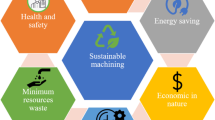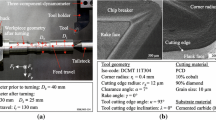Abstract
This study investigates the dry turning of cupola slag reinforced aluminium metal matrix composites (AMCs) with the aim of exploring the energy aspects and tool wear. The study involves the fabrication of cast cupola slag reinforced Al–4.5–Cu matrix composites by the economic stir casting method with varying the weight percentage of cupola slag (3 wt.%, 5 wt.% and 7 wt.%) followed by dry turning using coated carbide tool. The experimentation involves process input parameters such as spindle speed, feed rate and weight percentage of slag and the experimentation has been designed using statistical full factorial methodology. The energy aspects have been evaluated by measuring cutting force and power consumed during machining and tool wear have been measured using optical microscopy. The results showed that the cutting force and power consumption increase with increasing speed and feed rate decreases with increasing slag concentration. Slag incorporation has a significant effect on machinability as it eases the turning process when compared with base alloy. Moreover, detailed analyses of the effect of process input on the responses have been studied along with rigorous comparison of machining quality. The findings can be useful in optimizing the cutting conditions for improved energy efficiency and tool life in the machining of similar materials.
















Similar content being viewed by others
References
Ralph B, Yuen HC, Lee WB (1997) The processing of metal matrix composites—an overview. J Mater Process Technol 63:339–353. https://doi.org/10.1016/S0924-0136(96)02645-3
Surappa MK (2003) Aluminium matrix composites: challenges and opportunities. Sadhana Acad Proc Eng Sci 28:319–334. https://doi.org/10.1007/BF02717141
Adin MS (2023) Machining aerospace aluminium alloy with cryo-treated and untreated HSS cutting tools. Adv Mater Process Technol. https://doi.org/10.1080/2374068X.2023.2273035
Sikder R, Chakravarty S, Haldar P et al (2022) Scope for cupola slag reuse in construction: a sustainable green solution. Int J Environ Sci Technol. https://doi.org/10.1007/s13762-022-04257-x
Chakravarty S, Haldar P, Nandi T, Sutradhar G (2021) Cupola slag reutilization for sustainable waste management: review and economic analysis. Int J Environ Sci Technol. https://doi.org/10.1007/s13762-021-03574-x
Narasaraju G, Raju DL (2015) Characterization of Hybrid rice husk and fly ash-reinforced aluminium alloy (AlSi10Mg) composites. Mater Today Proc 2:3056–3064. https://doi.org/10.1016/j.matpr.2015.07.245
Siva SBV, Ganguly RI, Srinivasarao G, Sahoo KL (2013) Machinability of aluminum metal matrix composite reinforced with in-situ ceramic composite developed from mines waste colliery shale. Mater Manuf Process 28:1082–1089. https://doi.org/10.1080/10426914.2013.811734
Muthu P (2023) Optimization of dry sliding wear behaviour of industrial wastes reinforced aluminium based metal matrix composites. Materwiss Werksttech 54:327–334. https://doi.org/10.1002/mawe.202200172
Chakravarty S, Sikder R, Haldar P et al (2023) Experimental investigation on feasibility of industrial waste to resource conversion for cupola slag. Results Eng 17:100962. https://doi.org/10.1016/j.rineng.2023.100962
Dabade UA, Joshi SS (2009) Analysis of chip formation mechanism in machining of Al/SiCp metal matrix composites. J Mater Process Technol 209:4704–4710. https://doi.org/10.1016/j.jmatprotec.2008.10.057
Nataraj M, Balasubramanian K, Palanisamy D (2018) Influence of process parameters on CNC turning of aluminium hybrid metal matrix composites. Mater Today Proc 5:14499–14506. https://doi.org/10.1016/j.matpr.2018.03.037
Muthukrishnan N, Murugan M, Rao KP (2008) An investigation on the machinability of Al–SiC metal matrix composites using pcd inserts. Int J Adv Manuf Technol 38:447–454. https://doi.org/10.1007/s00170-007-1111-z
Wang Y, Liao W, Yang K et al (2019) Simulation and experimental investigation on the cutting mechanism and surface generation in machining SiCp/Al MMCs. Int J Adv Manuf Technol 100:1393–1404. https://doi.org/10.1007/s00170-018-2769-0
Suresh P, Marimuthu K, Ranganathan S, Rajmohan T (2014) Optimization of machining parameters in turning of Al–SiC–Gr hybrid metal matrix composites using grey-fuzzy algorithm. Trans Nonferrous Met Soc China 24:2805–2814. https://doi.org/10.1016/S1003-6326(14)63412-9
Dinaharan I, David Raja Selvam J, Jose J, Palanivel R (2023) Influence of fly ash particles on machining characteristics of AA6061 aluminum matrix composites produced using semisolid slurry casting. Trans Indian Inst Met. https://doi.org/10.1007/s12666-022-02869-y
Sahoo AK, Pradhan S (2013) Modeling and optimization of Al/SiCp MMC machining using Taguchi approach. Meas J Int Meas Confed 46:3064–3072. https://doi.org/10.1016/j.measurement.2013.06.001
Hooper RM, Henshall JL, Klopfer A (1999) Wear of polycrystalline diamond tools used in the cutting of metal matrix composites. Int J Refract Met Hard Mater 17:103–109. https://doi.org/10.1016/S0263-4368(98)00040-7
Maji P, Ghosh SK, Nath RK, Karmakar R (2020) Microstructural, mechanical and wear characteristics of aluminum matrix composites fabricated by friction stir processing. J Braz Soc Mech Sci Eng 42:191. https://doi.org/10.1007/s40430-020-02279-5
Murthy IN, Babu NA, Rao JB (2014) Comparative studies on microstructure and mechanical properties of granulated blast furnace slag and fly ash reinforced AA 2024 composites. J Miner Mater Charact Eng 02:319–333. https://doi.org/10.4236/jmmce.2014.24037
Chakravarty S, Haldar P, Nandi T, Sutradhar G (2023) Fabrication and machinability studies on cupola slag reinforced aluminium metal matrix composites using Taguchi method. Mater Today Proc. https://doi.org/10.1016/j.matpr.2023.02.080
Kiliçkap E, Çakir O, Aksoy M, Inan A (2005) Study of tool wear and surface roughness in machining of homogenised SiC−p reinforced aluminium metal matrix composite. J Mater Process Technol 164–165:862–867. https://doi.org/10.1016/j.jmatprotec.2005.02.109
Idrisi AH, Mourad AHI (2019) Conventional stir casting versus ultrasonic assisted stir casting process: mechanical and physical characteristics of AMCs. J Alloys Compd 805:502–508. https://doi.org/10.1016/j.jallcom.2019.07.076
Amirkhanlou S, Rezaei MR, Niroumand B, Toroghinejad MR (2011) Refinement of microstructure and improvement of mechanical properties of Al/Al2O3 cast composite by accumulative roll bonding process. Mater Sci Eng A 528:2548–2553. https://doi.org/10.1016/j.msea.2010.12.049
Behnamian Y, Serate D, Aghaie E et al (2022) Tribological behavior of ZK60 magnesium matrix composite reinforced by hybrid MWCNTs/B4C prepared by stir casting method. Tribol Int 165:107299. https://doi.org/10.1016/j.triboint.2021.107299
Lakshmi IG, Kanth YR, Rao JB (2022) Influence of Micro and nano particles on mechanical behaviour of slag reinforced AA7075 composites. Mater Sci Forum 1048:33–42. https://doi.org/10.4028/www.scientific.net/MSF.1048.33
Mallikarjuna C, Shashidhara SM, Mallik US, Parashivamurthy KI (2011) Grain refinement and wear properties evaluation of aluminum alloy 2014 matrix-TiB2 in-situ composites. Mater Des 32:3554–3559. https://doi.org/10.1016/j.matdes.2011.01.036
Ali M, Falih S (2014) Synthesis and characterization of aluminum composites materials reinforced with TiC nano-particles. Jordan J Mech Ind Eng 8:257–264
Bandil K, Vashisth H, Kumar S et al (2019) Microstructural, mechanical and corrosion behaviour of Al–Si alloy reinforced with SiC metal matrix composite. J Compos Mater 53:4215–4223. https://doi.org/10.1177/0021998319856679
Lakshmikanthan A, Bontha S, Krishna M et al (2019) Microstructure, mechanical and wear properties of the A357 composites reinforced with dual sized SiC particles. J Alloys Compd 786:570–580. https://doi.org/10.1016/j.jallcom.2019.01.382
Okayasu M, Wu S, Hasanah IU (2022) Effect of carbon nanotubes on the mechanical properties of cast Al–Si–Cu alloys. Mater Sci Technol (United Kingdom) 38:237–245. https://doi.org/10.1080/02670836.2022.2037058
Ma J, Ge X, Chang SI, Lei S (2014) Assessment of cutting energy consumption and energy efficiency in machining of 4140 steel. Int J Adv Manuf Technol 74:1701–1708. https://doi.org/10.1007/s00170-014-6101-3
Pul M, Yağmur S (2022) Examination of the effect of B4C and GNP reinforcements on machinability in the machining of Al 6061 matrix B4C/GNP reinforced hybrid composites. J Braz Soc Mech Sci Eng 44:469. https://doi.org/10.1007/s40430-022-03776-5
Balogun VA, Mativenga PT (2013) Modelling of direct energy requirements in mechanical machining processes. J Clean Prod 41:179–186. https://doi.org/10.1016/j.jclepro.2012.10.015
Suthar J, Patel KM (2018) Processing issues, machining, and applications of aluminum metal matrix composites. Mater Manuf Process 33:499–527. https://doi.org/10.1080/10426914.2017.1401713
Dinaharan I, Kalaiselvan K, Murugan N (2017) Influence of rice husk ash particles on microstructure and tensile behavior of AA6061 aluminum matrix composites produced using friction stir processing. Compos Commun 3:42–46. https://doi.org/10.1016/j.coco.2017.02.001
Ononiwu NH, Ozoegwu CG, Madushele N, Akinlabi ET (2021) Machinability studies and optimization of aa 6082/fly ash/carbonized eggshell matrix composite. Rev Des Compos Mater Av 31:207–216. https://doi.org/10.18280/rcma.310404
Ramesh Kumar C, JaiGanesh V, Malarvannan RRR (2019) Optimization of drilling parameters in hybrid (Al6061/SiC/B4C/talc) composites by grey relational analysis. J Braz Soc Mech Sci Eng 41:155. https://doi.org/10.1007/s40430-019-1661-7
Kaynak Y, Karaca HE, Noebe RD, Jawahir IS (2013) Tool-wear analysis in cryogenic machining of NiTi shape memory alloys: a comparison of tool-wear performance with dry and MQL machining. Wear 306:51–63. https://doi.org/10.1016/j.wear.2013.05.011
Muthukrishnan N, Murugan M, Prahlada Rao K (2008) Machinability issues in turning of Al–SiC (10p) metal matrix composites. Int J Adv Manuf Technol 39:211–218. https://doi.org/10.1007/s00170-007-1220-8
Grzesik W (2008) Advanced machining processes of metallic materials: theory, modelling and applications. Adv Mach Process Met Mater Theory Model Appl. https://doi.org/10.1016/B978-0-08-044534-2.X5001-2
Akhtar SS (2021) A critical review on self-lubricating ceramic-composite cutting tools. Ceram Int 47:20745–20767. https://doi.org/10.1016/j.ceramint.2021.04.094
Acknowledgements
This work was supported by Department of Science, Technology and Biotechnology, Government of West Bengal (Memo No.: 114 (Sanc.)/STBT–11012(16)/16/2021–ST SEC dated 28.04.2022).
Funding
This work was funded by Department of Science, Technology and Biotechnology, Government of West Bengal (Memo No.: 114 (Sanc.)/STBT–11012(16)/16/2021–ST SEC dated 28.04.2022).
Author information
Authors and Affiliations
Corresponding author
Ethics declarations
Competing interests
The authors have no competing interests to declare that are relevant to the content of this article.
Additional information
Technical Editor: Lincoln Cardoso Brandao.
Publisher's Note
Springer Nature remains neutral with regard to jurisdictional claims in published maps and institutional affiliations.
Rights and permissions
Springer Nature or its licensor (e.g. a society or other partner) holds exclusive rights to this article under a publishing agreement with the author(s) or other rightsholder(s); author self-archiving of the accepted manuscript version of this article is solely governed by the terms of such publishing agreement and applicable law.
About this article
Cite this article
Chakravarty, S., Sikder, R., Haldar, P. et al. Exploring energy aspects and tool wear on dry turning of cupola slag-reinforced aluminium metal matrix composites. J Braz. Soc. Mech. Sci. Eng. 46, 59 (2024). https://doi.org/10.1007/s40430-023-04651-7
Received:
Accepted:
Published:
DOI: https://doi.org/10.1007/s40430-023-04651-7




